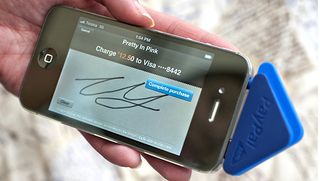The end of cash
No more fumbling for coins or even waiting in queues
Apple has instead released Passbook — essentially a digital replica of that part of your wallet or purse where you store tickets or loyalty cards — but no NFC and no way to make payments. Some argue that Apple isn't convinced NFC is ripe or necessarily the right technology for contactless payment.
Contactless payment trials
The banks aren't waiting for Apple; for example, Westpac has embraced the many Android phones that now ship with NFC. The bank has a trial under way with Oberthur Technologies and Optus, which will allow it to turn Android phones into contactless payments devices.
Because the technology in most chipped (rather than magnetic stripe) debit or credit cards is functionally very similar to that in a phone's SIM card — even down to the operating system — it's possible to program the card details into the secure element of the SIM card with the co-operation of the issuing telecommunications carrier (Optus in this case).
In the Westpac pilot Oberthur, which provides what's known as a Trusted Service Manager (TSM) platform, encodes a customer's debit MasterCard information on the secure element of the SIM card in the phone.
The mobile payment application is loaded onto the phone and when making a payment, the phone connects the NFC antenna inside the phone to the SIM card and allows a contactless payment to occur.
The debit card details on the SIM are protected as they're stored in the secure element of the card and protected by MasterCard's security standards, which is the EMV (Europay, MasterCard and Visa) standard. As soon as a phone is reported lost or stolen, the card details will be blocked.
It's scheduled for general release in 2013, like Westpac's wallet.
Get daily insight, inspiration and deals in your inbox
Get the hottest deals available in your inbox plus news, reviews, opinion, analysis and more from the TechRadar team.
How long?
Despite all the activity, Guy Cranswick, a technology analyst with IBRS, believes it will take at least three years for the business case for mobile payments to stack up.
He thinks that while people are generally happy enough to use their smartphones to access bank web sites and check balances, it will take longer for people to view their mobile phone as a digital wallet and a replacement for cash.
At the very least, the vast majority of Australia's 750,000 EFTPOS terminals will need to be upgraded to be able to accept contactless payments and handle people using discount vouchers or loyalty points stored in their digital wallet.
Cranswick thinks an interbank real-time payment capability will also be needed to drive digital wallets. Real-time payments are possible within the four walls of most banks — if you go online and transfer money from one St George account to another, that shows up immediately.
But if one person involved in a transaction has their accounts with a different bank, the payment loop can't close before the overnight interbank batch processing run.
Alternatives to banks
Smartphone-centred payment platforms from non-banks such as PayPal, Google and Square in the US are also emerging, and will help develop the 'muscle memory' Clive Whincup talks of.
But where local banks may have something of an advantage over the internet giants is the ability to keep payment charges low.
For example, Facebook charges 30% on the clip of anything paid to merchants using Facebook credits, while PayPal's rack rate is 2.4% of the transaction plus 30c per transaction.
But PayPal still reckons the convenience it offers stacks up. In March last year, it announced a free app and dongle that turned a smartphone into an EFTPOS terminal. Called PayPal Here, the system is aimed at small businesses and market stall operators.

The banks are in on the act, too, creating their own smartphone-centred payment platforms systems. Commonwealth Bank has unveiled a payment platform called Pi and two devices — a case that turns a smartphone into an EFTPOS terminal and a tablet that can be used to accept payments.
Meanwhile, ANZ has FastPay, which lets businesses collect credit or debit card payment details before 6.30pm and have the cash credited to their accounts on the same day (although that's a manual input system — there's as yet no swipe dongle for this process).
Cash will survive for some years yet, but it's feeling the hot breath of the smartphone on its neck already.
User story:
James Ashton works on soundtracks for feature films and is a self-confessed early adopter of new technologies. Ashton banks with NAB and uses its mobile banking apps — now on an Android device, although he started off on an (now lost) iPhone.

It's the convenience of anytime, anywhere banking that Ashton likes — the ability to quickly send a payment from his mobile to a friend to buy a ticket for a show, or check his account balance before making a major payment.
When he lost the iPhone he wasn't too worried — he'd set up the security so that after 10 failed attempts to get into the phone all the information would be wiped.
In any case, his financial information wasn't stored on the phone, but remained secure in NAB's data centre. Ashton also uses the phone to make payments using PayPal, generally when he's buying from eBay, and would like to be able to use the smartphone to make contactless payments.
However, to date, NAB is the only one of the big four banks that has yet to declare its contactless payment plans.
So could the phone replace cash and his wallet? Ashton's not so sure. "The biggest issue is whether every company or provider could use it. And you may end up with 30 different apps to scan… But if there was a unified system then I'd definitely be interested in giving it a go."
Most Popular
